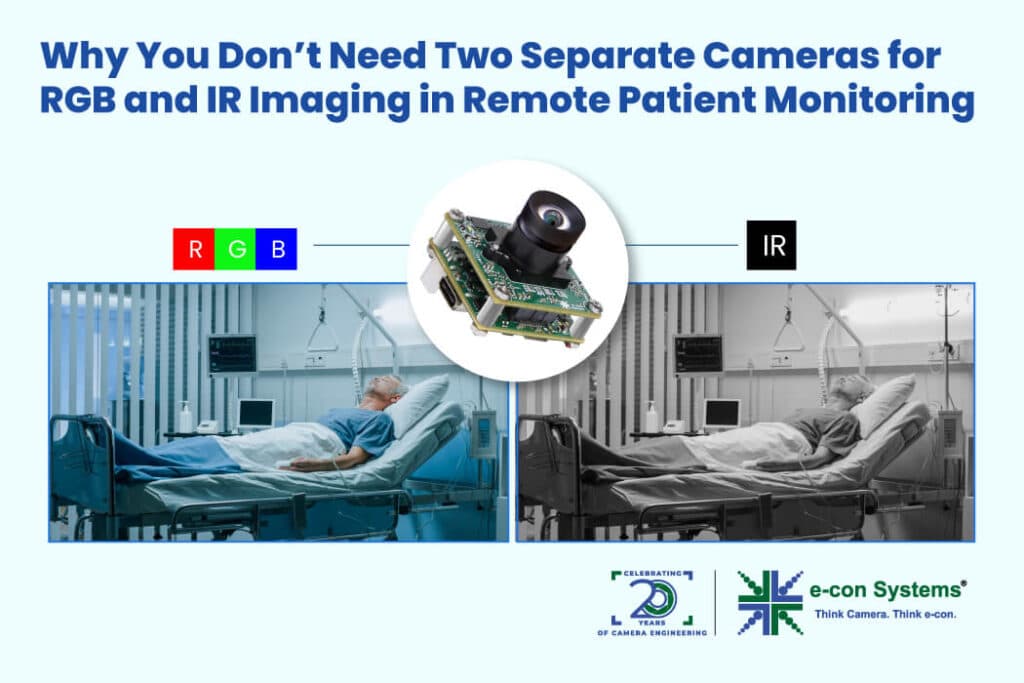This blog post was originally published at e-con Systems’ website. It is reprinted here with the permission of e-con Systems.
This blog post explores how RGB-IR cameras simplify remote patient monitoring (RPM) by eliminating the need for separate day and night cameras. It highlights their benefits, including compact design, reduced power consumption, and simultaneous RGB and IR imaging, making RPM systems more efficient and cost-effective.
Camera-enabled Remote Patient Monitoring (RPM) or virtual nursing systems have helped mitigate healthcare challenges like monitoring patients during COVID-19 and managing the scarcity of medical resources by providing continuous 24×7 remote monitoring.
Cameras were initially used to detect the presence or absence of patients and their basic movements. However, recent camera technology advancements, along with AI and ML integration, have led to the rise of a comprehensive RPM system capable of movement monitoring, fall detection (even fall prevention), and facial expression analysis for pain assessment
One such technology is the RGB-IR camera, which is increasingly being used in RPM systems. RGB-IR cameras can capture both white light RGB and monochrome IR images, eliminating the need for two separate cameras. These cameras prove to be a cost and space-efficient alternative to traditional cameras.
In this blog, you’ll learn about the benefits of eliminating two separate cameras for RGB and IR imaging in RPM applications.
Eliminating the Need for Two Separate Cameras in RPM
Camera-based remote patient monitoring systems generally use two methods for round-the-clock monitoring.
- Two separate cameras for day and night monitoring
- A single camera that uses an IR-cut filter to block the IR light during the daytime
On the one hand, using two cameras results in the devices becoming power-consuming, expensive and cumbersome to handle. On the other, mechanical lens filters used in cameras are prone to wear and tear, resulting in reduced product lifetime.
With the help of continuous efforts, engineers have developed RGB-IR cameras which prove to be a superior alternative for the above solutions. RGB-IR cameras eliminate the need for two cameras as well as mechanical lens filters, offering both day and night imaging in a single device.
To learn more on how RGB-IR cameras work, read:
Therefore, using RGB-IR cameras in Remote Patient Monitoring or virtual nursing systems eliminates the need for two separate cameras for RGB and IR imaging. Some of its key benefits include.
Benefits of RGB-IR Cameras in Remote Patient Monitoring or Virtual Nursing
Day and night mode switching
RGB-IR cameras use lenses with dual bandpass filters, unlike standard lenses that use IR-cut filters, to allow both visible and NIR light to reach the sensor. It enables RGB-IR cameras to capture images in both RGB and IR modes, eliminating the need for mechanical lens filters, which are typically used in traditional cameras.
Enhanced Imaging in no-light conditions
RGB-IR cameras have sensors that have dedicated IR pixels on their surface. The IR component of RGB-IR cameras enabled clear and detailed imaging even in total darkness. It can be crucial for night-time monitoring, as it enables healthcare providers to observe patients without the need for external lighting that could disturb their rest.
Compact form factor
By integrating the functionality of RGB and IR imaging into a single device, RGB-IR cameras offer a compact form factor. Such a design reduces the need for two cameras, simplifying integration into RPM systems and saving valuable space. The streamlined design makes the equipment more manageable and contributes to a more efficient setup.
Reduced power consumption and costs
Integrating RGB and IR imaging into a single device ensures lower power consumption when compared to using separate cameras for each function. The reduction in power usage translates to decreased operational costs and contributes to the sustainability of remote patient monitoring systems. By combining two functions into one device, RGB-IR cameras help lower energy consumption while reducing the long-term expenses of equipment maintenance and operation.
Simultaneous RGB and IR imaging
RGB-IR cameras excel at capturing color (RGB) and infrared (IR) images simultaneously within a single frame. The dual imaging capability provides a full view of the patient’s condition by integrating visible light details with infrared insights. It ensures a more complete and accurate assessment of the patient’s health, as both types of data are available in real-time for enhanced monitoring.
Latest Updates on e-con Systems’ RGB-IR Cameras
Since 2003, e-con Systems has been designing, developing, and manufacturing OEM cameras. We are excited to launch our flagship See3CAM_CU83 – a 4K AR0830 RGB-IR USB 3.2 Gen 1 Camera for Remote Patient Monitoring and virtual nursing systems. This camera features our patented algorithm for processing RGB and IR frames separately.
This innovation in See3CAM_CU83 ensures simultaneous RGB and IR imaging, delivering high-quality performance in all lighting conditions.
To learn more about the medical applications we serve, explore our Medical Market Page.
You can also visit our Camera Selector to get a full view of our camera portfolio.
If you need any help in picking and integrating the right cameras into your medical devices, please write to [email protected].
Balaji S
Product Manager, e-con Systems


